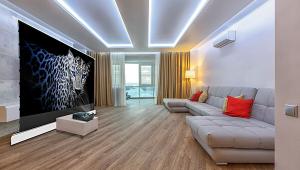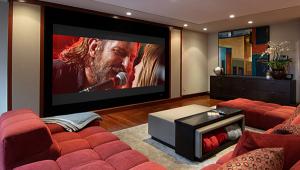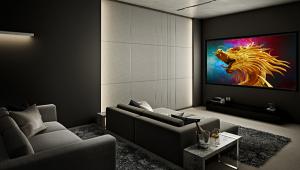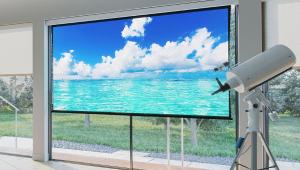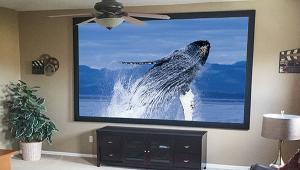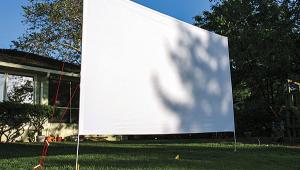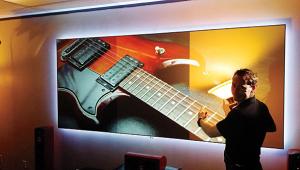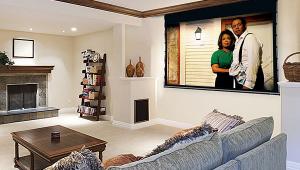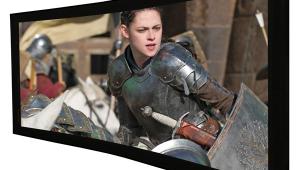Stewart Filmscreen StudioTek 130 G4 Projection Screen Review Page 2
The first good sign for the ST130 G4 material was when I checked my projector's focus after re-mounting the screen— it hadn't changed at all. I use a single-pixel on/off test pattern from the Spears and Munsil UHD Benchmark disc to set focus, and each of the pixels in the pattern were razor-sharp with no signs of compromise. Next, I proceeded to calibrate the projector to take into account the new peak white point and any color shift that may have resulted from the change in material. Once that was done, testing could begin.
The first video I wanted to view on the ST130 was one I use to quickly reveal any artifacts related to a gain screen's texture: The Art of Flight, a snowboarding documentary with lots of nearly pure white images with near-constant side to side and up and down camera moves. This is a brutal test for any screen, and even the ST100 will show a miniscule amount of texture on it if you know what to look for. Once I watched The Art of Flight on the ST130 G4, I was actually stunned with how well the new material performed. Screen texture was barely visible, even with pans across the beautiful snow-capped mountain peaks. I wasn't getting a nearly perfect absence of artifacts as I do with Stewart's ST100, but it was far closer than I expected given the performance of the third-generation ST130 material, which had displayed a fair number of artifacts with this disc.
The only time I thought the artifacts were an issue with the new ST130 G4, and by "issue" I mean where people would actually notice artifacts if they were actively looking for them, was on vertical tilt shots. For some reason, scenes that featured a vertical tilt (camera moves up and down) seemed to reveal a bit of screen texture—mainly, a slight sheen—though I didn't see any "sparkle" regardless of how the camera was moving.
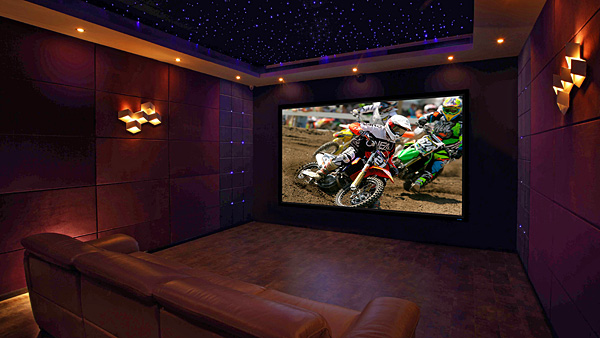
I also noted some slight gain-related sheen on really bright white objects, but it didn't call attention to itself as with previous generations of the ST130 material. To say that I was pleasantly surprised by how much the new screen reduced such artifacts is an understate- ment—this material reminds me far more of the ST100 and its nearly imperceptible texture. The next thing I wanted to test for was artifacts related to the gain of the screen itself. Gain is useful for bumping up overall image brightness, but can add its own visible signature as well, something referred to as "hot spotting." Since gain focuses the light coming from a specific angle and rejects a bit of light coming from other angles, it can create a brighter area in the screen's center compared with its outer edges. Since it has no gain, my reference ST100 is about 20-30 percent "dimmer" (if compared directly with the same light source reflecting off of it) than the ST130 G4, but it has greater brightness uniformity since it reflects light evenly across the entirety of its surface area.
Near-black to 100 percent white full-field images showed no obvious hot spotting on the ST130 G4, which is the level of performance I would expect from one of Stewart's reference screens. The gain windowing of the material also helps a bit to reject any stray light coming toward the screen from the sides. This not only helps with contrast performance, but also with other issues related to specific projectors. A good example would be the slight brightness increase in the corners of the image that I've seen with JVC projectors. A screen such as the ST130 G4 can help to reverse that artifact since its corners have a slightly lower gain than the center. (That's why I mentioned earlier that the relationship between projector and the screen should always be considered, because both components contribute to image quality as a whole.)
I made it a point to evaluate as many "reference" Ultra HD Blu-ray discs that I could, with a focus on titles that would make my "best of" list for fine detail. Some that immediately came to mind were Lucy, The Revenant, Blade Runner 2049, and Moana. I wanted to be absolutely certain that the texture of the screen (as I mentioned above, there will always be some degree of texture with a gain screen) didn't call attention to itself and wouldn't even be a factor unless I was specifically looking for it. Even the most demanding shots from Lucy and The Revenant showed no obvious texture artifacts, and every ounce of detail was preserved.
Poring through disc after disc, I was consistently impressed with how little the ST130 G4 revealed itself. Images with bright, pure-white areas always provided the best chance to look for artifacts, and from my normal seating position (13 feet back from a 10-foot-wide 2.35:1 aspect ratio screen) they were barely visible. During my testing, I had a fellow professional calibrator visit who shared my opinions on the previous-generation ST130 (he currently has one in his theater), and he also commented on how much more transparent the new screen was with all the movie scenes we viewed. Now, after spending a few weeks viewing with the ST130 G4, I continue to be impressed, and I'm also downright smitten with the extra brightness I'm getting with 4K/ HDR images after switching out the ST100.
Conclusion
When it comes to a reference screen, I still put Stewart Filmscreen's StudioTek 100, a material that imparts almost nothing on the image reflecting off of it, at the top of the heap. But the ST100 is also a material that demands a near-perfect, black-hole viewing environment, and a projector that provides sufficient brightness—a difficult proposition when you move to larger screen sizes. The company's new StudioTek 130 G4 screen material narrows the performance gap between the two lines and provides a great new option for those seeking a brightness bump without the artifacts that typically accompany gain screens. I think only the pickiest videophile would find texture to be an issue with this new screen, and then only if they were going out of their way to spot it. With the new ST130 G4, Stewart has massively improved what was already one of the industry's best screens. If you're looking for a true reference gain screen for your theater, it should be at the top of your list.
Note: The Where to Buy link below is an affiliate link. If you purchase through the link, we may earn a small commission at no extra cost to you. Thank you for your support!
